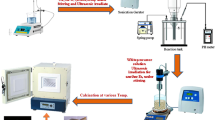Abstract
Microscale zirconia structures with intricate three-dimensional (3D) shapes and nanoscale features were synthesized using diatom (single-celled algae) microshells as transient scaffolds. After exposure to a zirconium alkoxide-bearing solution and firing at 550–850 °C, silica-based diatom microshells were coated with a thin, continuous nanocrystalline zirconia layer. Predominantly tetragonal or monoclinic zirconia could be produced with appropriate heat treatments. Selective silica dissolution then yielded freestanding zirconia micro-assemblies that retained the microshell shape and fine features. Such hybrid (biological/synthetic chemical) processing may be used to mass-produce nanostructured micro-assemblies with a variety of 3D, biologically replicable shapes and tailored compositions for use in numerous applications.
Similar content being viewed by others
References
I. Birkby and R. Stevens: Applications of zirconia ceramics, Key Eng. Mater. 122, 527 (1996).
B. Li and R.D. Gonzalez: Sol-gel synthesis and catalytic properties of sulfated zirconia catalysts, Ind. Eng. Chem. Res. 35, 3141 (1996).
A.V. Shevchenko, E.V. Dudnik, A.K. Ruban, V.P. Red’ko, V.M. Vereschaka, and L.M. Lopato: Nanocrystalline powders based on ZrO2 for biomedical applications and power engineering, Powder Metall. Met. Ceram. 41, 558 (2002).
O. Vasylkiv, Y. Sakka, and V.V. Skorokhod: Low-temperature processing and mechanical properties of zirconia and zirconia-alumina nanoceramics, J. Am. Ceram. Soc. 86, 299 (2003).
M. Boaro, A. Trovarelli, H.-J. Hwang, and T.O. Mason: Electrical and oxygen storage/release properties of nano-crystalline ceria-zirconia solid solutions, Solid State Ionics 147, 85 (2002).
G. Soyez, J.A. Eastman, L.J. Thompson, R.-G. Bai, P.M. Baldo, A.W. McCormick, R.J. DiMelfi, A.A. Elmustafa, M.F. Tambwe, and D.S. Stone: Grain-size-dependent thermal conductivity of nanocrystalline yttria-stabilized zirconia films grown by metal-organic chemical vapor deposition, Appl. Phys. Lett. 77, 1155 (2000).
J.J. Storhoff, R.C. Mucic, and C.A. Mirkin: Strategies for organizing nanoparticles into aggregate structures and functional materials, J. Cluster Sci. 8, 179 (1997).
E. Rabani, D.R. Reichman, P.L. Geissler, and L.E. Brus: Drying-mediated self-assembly of nanoparticles, Nature 426, 271 (2003).
H.A. Lowenstam and S. Weiner: Mineralization by organisms and the evolution of biomineralization, in Biomineralization and Biological Metal Accumulation, edited by P. Westbroek, and de E.W. Jong (D. Reidel Publishing Co., Dordrecht, Holland, 1983), p. 191.
F.E. Round, R.M. Crawford, and D.G. Mann: The Diatoms: Biology & Morphology of the Genera (Cambridge University Press, Cambridge, U.K., 1990).
S.A. Crawford, M.J. Higgins, P. Mulvaney, and R. Wetherbee: Nanostructure of the diatom frustule as revealed by atomic force and electron microscopy, J. Phycol. 37, 543 (2001).
T. Lebeau and M.-J. Robert: Diatom cultivation and biotechnologically relevant products. Part I: Cultivation at various scales, Appl. Microbiol. Biotechnol. 60, 612 (2003).
J. Parkinson and R. Gordon: Beyond micromachining: The potential of diatoms, Trends Biotechnol. 17, 190 (1999).
C.W. Mehard, C.W. Sullivan, F. Azam, and B.E. Volcani: Role of silicon in diatom metabolism. IV. Subcellular localization of silicon and germanium in Nitzschia alba and Cylindrotheca fusiformis, Physiol. Plant. 30, 265 (1974).
K.H. Sandhage, M.B. Dickerson, P.M. Huseman, M.A. Caranna, J.D. Clifton, T.A. Bull, T.J. Heibel, W.R. Overton, and M.E.A. Schoenwaelder: Novel, bioclastic route to self-assembled, 3D, chemically tailored meso/nanostructures: shape-preserving reactive conversion of biosilica (diatom) microshells, Adv. Mater. 14, 429 (2002).
R.R. Unocic, F.M. Zalar, P.M. Sarosi, Y. Cai, and K.H. Sandhage: Anatase assemblies from algae: Coupling biological self-assembly of 3-D nanoparticle structures with synthetic reaction chemistry, Chem. Comm. 7, 795 (2004).
M.W. Anderson, S.M. Holmes, N. Hanif, and C.S. Cundy: Hierarchical pore structures through diatom zeolitization, Angew. Chem. Int. Ed. Engl. 39, 2707 (2000).
C.S. Gaddis and K.H. Sandhage: Freestanding microscale 3-D polymeric structures with biologically-derived shapes and nanoscale features, J. Mater. Res. 19, 2541 (2004).
J.A. Wang, M.A. Valenzuela, J. Salmones, A. Vazquez, A. Garcia-Ruiz, and X. Bokhimi: Comparative study of nanocrystalline zirconia prepared by precipitation and sol-gel methods, Catal. Today 68, 21 (2001).
H. Li, K. Liang, S. Gu, and G. Xiao: Oriented nanostructured ZrO2 thin films on fused quartz substrate by sol-gel process, J. Mater. Sci. Lett. 20, 1301 (2001).
B.D. Cullity: Elements of X-ray Diffraction (Addison-Wesley Publishing Co., Reading, MA, 1978), p. 101.
Y. Kanno: Thermodynamic and crystallographic discussion of the formation and dissociation of zircon, J. Mater. Sci. 24, 2415 (1989).
T. Itoh: Zircon ceramics prepared from hydrous zirconia and amorphous silica, J. Mater. Sci. Lett. 13, 1661 (1994).
T.G. Dunahay, E.E. Jarvis, and P.G. Roessler: Genetic transformation of the diatoms Cyclotella Cryptica and Navicula Saprophila, J. Phycol. 31, 1004 (1995).
L.A. Zaslavskaia, J.C. Lippmeier, P.G. Kroth, A.R. Grossman, and K.E. Apt: Transformation of the diatom Phaeodactylum Tricornutum (Bacillariophyceae) with a variety of selectable marker and reporter genes, J. Phycol. 36, 379 (2000).
Web site of the Joint Genome Institute: U.S. Department of Energy: http://genome.jgi-psf.org/thaps1/thaps1.home.html.
Author information
Authors and Affiliations
Corresponding author
Rights and permissions
About this article
Cite this article
Zhao, J., Gaddis, C.S., Cai, Y. et al. Free-standing microscale structures of nanocrystalline zirconia with biologically replicable three-dimensional shapes. Journal of Materials Research 20, 282–287 (2005). https://doi.org/10.1557/JMR.2005.0046
Received:
Accepted:
Published:
Issue Date:
DOI: https://doi.org/10.1557/JMR.2005.0046




